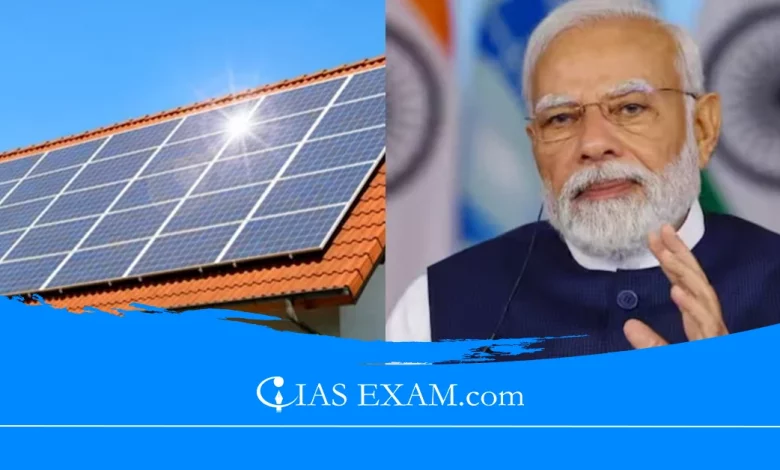
Context
The Centre has recently tweaked the new ₹75,000-crore PM-Surya Ghar Muft Bijli Yojana (Prime Minister’s Rooftop Solar: Free power Scheme).
About
- Originally, the plan aimed to fully pay for 1-3 KW solar system installations in one crore families by partnering with renewable power service agencies.
- Now, the scheme will only cover up to 60% of the installation costs.
- Households looking to enjoy the scheme must pay the final amount and at the least ₹20,000, depending on the installed system’s power capacity.
- They can get a low-interest, collateral-free loan to help cover the cost.
- To be eligible, houses must have a suitable roof and be connected to the grid. Consumers are still responsible for buying all the power they use from the grid.
India’s current solar power
- Installed capacity
-
-
- According to the Ministry of New and Renewable Energy, solar power installed capacity in India has reached around 73.31 GW as of December 2023.
- Meanwhile, rooftop solar mounted capacity is around 11.08 GW as of December 2023.
- India was to have installed 40 GW of rooftop-solar by 2022.
- Overall, solar power has a prime proportion in the country’s current renewable energy capacity, which stands at around 180 GW.
-
- High appearing states
-
- In terms of overall solar power, Rajasthan is on the top with 18.7 GW. Gujarat is at the second position with 10.5 GW.
- When it involves rooftop solar capacity, Gujarat tops the list with 2.8 GW, followed by Maharashtra by 1.7 GW.
Need for an expansion of solar power in India
- According to the recent World Energy Outlook through the International Energy Agency (IEA), India is expected to witness the largest energy demand growth of any country or region in the world over the next 30 years.
- IEA is an intergovernmental organisation that offers data, coverage tips, and evaluation on the global power sector.
- To meet this demand, the country might want a dependable supply of power and it can’t be just coal plants.
- Although India has doubled down on its coal production in recent years, it also has ambitions to reach 500 GW of renewable power capacity by 2030.
PM Surya Ghar Muft Bijli Yojana
-
- It is a scheme that aims to offer unfastened energy to families who prefer to install rooftop solar power systems.
- The families will be able to get 300 units of power free every month.
- The scheme specializes in the family section with up to 3 kW system, which covers most of the residential consumers in India.
- Subsidies provided
-
-
- A subsidy of 60% of the cost for systems up to two kW capacity and 40% of cost for systems between 2-3 kW has been announced.
- The subsidy has been capped at 3 kW capacity, which means financial aid will not be provided for power beyond 3 kW.
- At current benchmark expenses, Rs 30,000 subsidy could be provided for 1 kW system, Rs 60,000 for two kW structures and Rs 78,000 for 3 kW systems or higher.
-
- Process of getting system installed
-
-
- Any resident with a roof suitable for installing solar panels can observe by means of first registering on the national rooftop solar portal.
- The consumer can pick out a dealer from the list furnished at the portal.
- The carriers are registered with the distribution businesses, but in future there will be a national registry as well.
- A legitimate power connection is required for it and the family need to not have availed every other subsidy for solar panels.
-
- Funding
-
-
- The government has announced central financing of Rs 75,021 crore, with a view to frequently accept as an instantaneous subsidy to the customer.
- The scheme affords an issue for charge security for renewable power carrier business enterprise-based models as well as a fund for innovative tasks.
- Public sector organisations are expected to step in if the response is slow in sure areas or clusters no matter the subsidy.
- State-run power companies are likely to put money into solar rooftop structures and gather revenue from the excess power bought in the grid.
-
- Benefits
-
- Free electricity for households.
- The free component will reduce one’s electricity bill.
- One will get a payback and that may vary from 3 to 7 years.
- Reduced power expenses for the government.
- Increased use of renewable energy.
- Reduced carbon emissions.
- Free electricity for households.
Source: The Economic Times
UPSC Mains Practice Question
Q. As a panacea to the growing energy needs of India, discuss the relevance of One Sun PM-Surya Ghar Muft Bijli Yojana. (250 words)





.png)



